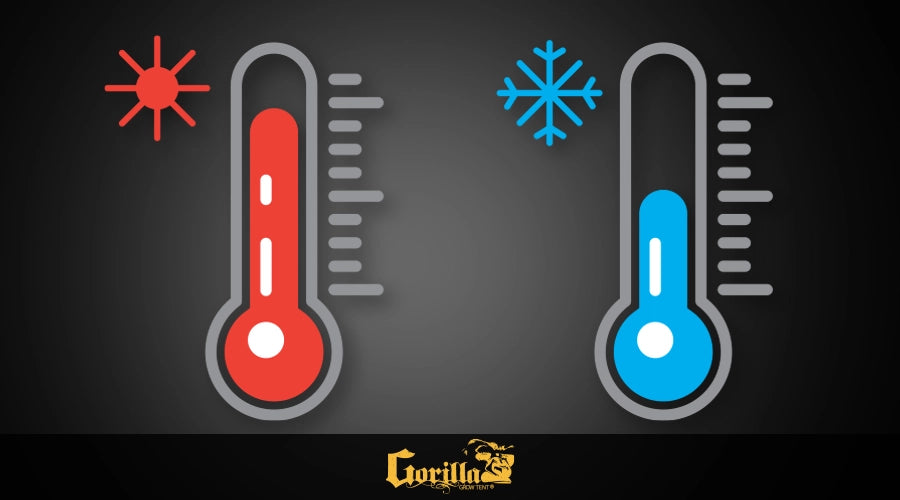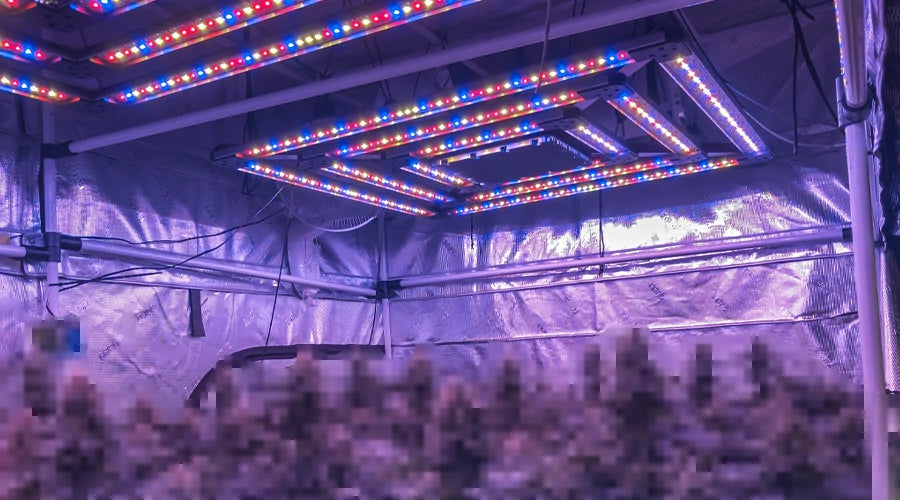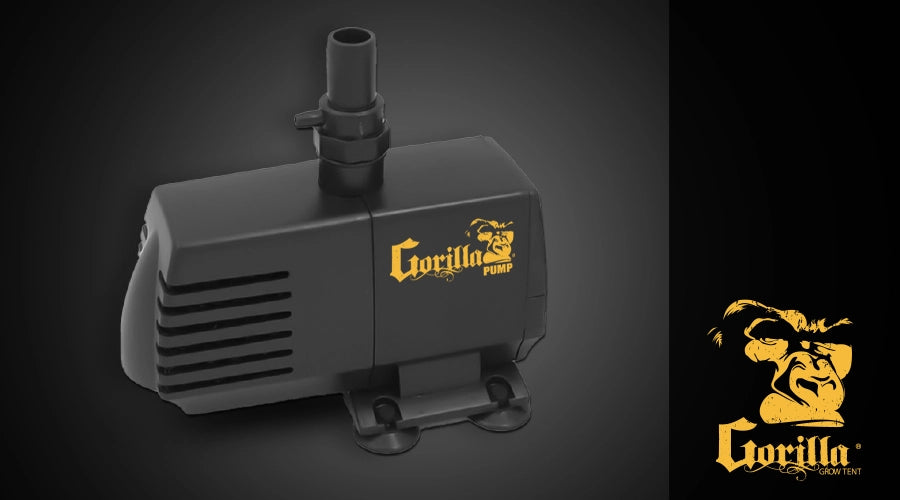
LED Grow Light Heat Output: Managing Temperature for Optimal Growth
It is a fact that LED grow lights, which have managed to become an important part of indoor gardening, are becoming more and more popular among indoor growers as they have many advantages over traditional lighting methods such as HID and fluorescent lamps.
So what advantages are these? LED grow lights are more energy efficient, last longer, and can produce light that is more tailored to the specific needs of plants.

How to Manage Temperature for Optimal Growth
However, one of the main concerns growers are concerned with when using LED grow lights is managing the heat output. In this article, we'll look at together how to manage temperature for optimum growth when using LED grow lights.
Tips for Managing Temperature in Your Indoor Garden with LED Grow Lights
Understanding the relationship between heat and light
Heat and light are closely related when it comes to plant growth. Plants need light to perform photosynthesis, the process by which they convert light energy into chemical energy that they can use for growth. However, too much heat can damage plants, especially if not properly managed. High temperatures can stress plants and affect their growth and yield.
Choose the right LED grow light
The first step in managing temperature when using LED grow lights is choosing the right light for your specific growing needs. Look for lights with a high efficiency rating meaning they produce more light with less heat. LED grow lights come in different wattages, so be sure to choose the right one for the size of your grow area. It's also important to consider the color spectrum of light, as different plants have different light requirements.
Use a fan or ventilation system
Proper ventilation is essential to manage heat when using LED grow lights. A fan or ventilation system can help circulate air and reduce heat build-up. Be sure to place the fan or ventilation system so that it provides optimum air circulation around your plants.

Monitor temperature and humidity levels
Regularly monitoring the temperature and humidity levels in your growing area is essential to ensure optimum plant growth. You can use a digital thermometer and hygrometer to measure temperature and humidity levels. Aim for a temperature range of 65-80°F (18-27°C) and a humidity level of 40-60%. If temperature or humidity levels are outside this range, adjust your ventilation system accordingly.
Use a heat sink
A heat sink is a device that helps dissipate heat away from the LED grow light. It is made of a material with high thermal conductivity such as aluminum. A cooler can help lower the temperature of your growing area and prevent heat build-up around your plants.
Consider adding CO2
Increasing the amount of CO2 in your growing area can help increase plant growth and yield. However, it is important to note that adding CO2 can also increase temperature levels. If you choose to add CO2, be sure to closely monitor temperature levels and adjust your ventilation system accordingly.
LED Grow Lights for Herbs: Healing Your Homemade Spices
Are LED grow lights beneficial for the plants you are growing?
Yes, LED grow lights can be very helpful for growing plants indoors. Plants need a lot of light to grow and thrive, and LED grow lights are an efficient and cost-effective way to provide the light needed for plant growth.
LED grow lights are also beneficial because they emit light at specific wavelengths that plants need for photosynthesis. This means they can be adjusted to provide the optimal light spectrum for plants and support healthy growth and development.
Plus, LED grow lights are energy efficient and generate less heat than traditional lighting sources, making them a safer and more sustainable option for indoor herb gardening.
Herbs Love LED: Maximizing Your Homegrown Spice Yield
If we briefly title and explain the main features of LED grow lights that you can use for plants:
Customizable light spectrum:
LED grow lights allow you to customize the light spectrum to suit your plants' needs. You can adjust the intensity and color of the light to suit the growth stage of your plants, whether in the vegetative or flowering stage.
Efficient energy:
LED grow lights consume less energy compared to traditional lighting sources, making them a cost-effective option in the long run. They also generate less heat and reduce the risk of plant damage due to overheating.
Longevity:
LED grow lights have a longer lifespan compared to other grow lights, so you don't need to replace them as often. This also makes them more environmentally friendly as you will produce less waste.
Space saving:
Because LED grow lights can be placed closer to plants, they take up less space than traditional grow lights. This makes them ideal for small spaces or indoor herb gardens.
Environmental Benefits of Using LED Grow Lights for Indoor Gardening
LED grow lights have been the rising star of indoor gardening in recent years.
The biggest advantage of using LED grow lights is that they are a more energy-efficient and environmentally friendly option for growing plants indoors compared to traditional lighting methods such as high-pressure sodium (HPS) or metal halide (MH) lamps.
The Environmental Benefits of Using LED Grow Lights in Your Home
In this article, we will talk about the environmental benefits of using LED grow lights for indoor gardening.
Energy efficiency:
LED grow lights are more energy efficient compared to traditional lighting methods. They use less electricity to produce the same amount of light, which can save significant energy over time. According to a study by the US Department of Energy, LED grow lights can save up to 40% energy compared to traditional lighting methods.
Lower Heat Emissions:
LED grow lights generate less heat compared to traditional lighting methods. This means less energy is needed to cool the growing medium and reduces the overall energy consumption of indoor garden installations. In addition, less heat can mean a reduced risk of fire hazards, which is an added benefit.
Reduced Carbon Footprint:
LED grow lights have a lower carbon footprint compared to traditional lighting methods. This is because they need less energy to operate and generate less heat, which reduces the overall energy consumption of indoor garden installations. Additionally, LED grow lights can last up to 50,000 hours, which means fewer replacements and less waste.
Reduced Water Consumption:
LED grow lights can help reduce water consumption in indoor garden setups. Because they produce less heat, the growing environment needs less water to maintain moisture levels. This means less water is wasted through evaporation, resulting in a more efficient use of water resources.
Does Not Contain Harmful Chemicals:
Conventional lighting methods for indoor gardening, such as high-pressure sodium lamps, often contain harmful chemicals such as mercury, which can be released into the environment when discarded. LED grow lights, on the other hand, do not contain harmful chemicals, making them a safer and more environmentally friendly option.
Reduced Light Pollution:
LED grow lights emit light in a specific spectrum that plants need to grow, which means plants can be directed exactly where they need it. This reduces light pollution, which can negatively affect the natural behavior of animals and insects, disrupt ecosystems and waste energy.
Lower Maintenance Costs:
LED grow lights have a longer lifespan compared to traditional lighting methods, meaning less frequent replacement and maintenance costs. This results in less waste and lower environmental impact associated with the manufacture and disposal of replacement lamps.
Less Dependency on Fossil Fuels:
Indoor garden installations using LED grow lights can be powered by renewable energy sources such as solar or wind power, reducing their dependence on fossil fuels. This can further reduce carbon footprints and contribute to a more sustainable future.
The Importance of Ventilation in Grow Tents: A Breath of Fresh Air for Healthy Plants
Proper ventilation plays a crucial role in the success of indoor gardening, especially in the context of grow tents. Grow tents provide a controlled environment for plants, but without adequate ventilation, the air inside can become stagnant, leading to a range of issues that can impact plant health and productivity. In this article, we will explore the importance of ventilation in grow tents and the benefits it brings to ensure the optimal growth of your indoor plants.
Air Flow Matters: Understanding the Importance of Ventilation in Grow Tents
Regulating Temperature and Humidity:
Ventilation helps regulate temperature and humidity levels within the grow tent. Plants require specific temperature and humidity ranges for optimal growth. Insufficient airflow can result in high temperatures, leading to heat stress, wilting, and reduced photosynthesis. Additionally, poor ventilation can cause excessive humidity, creating a favorable environment for mold, mildew, and fungal diseases. Proper ventilation ensures a stable and balanced climate, creating an environment where plants can thrive.
Promoting Air Exchange and CO2 Levels:
Plants need a constant supply of fresh air to thrive. Ventilation promotes air exchange, replacing stale air rich in carbon dioxide (CO2) with fresh air containing higher oxygen levels. Adequate oxygen supply is crucial for healthy root development and overall plant growth. In addition, sufficient CO2 levels are essential for photosynthesis, and proper ventilation ensures a steady influx of CO2, maximizing plant productivity.
Preventing the Build-Up of Harmful Gases:
In a closed environment like a grow tent, certain gases can accumulate and harm plants. For example, ethylene, a gas produced by ripening fruits or decaying plant material, can inhibit growth and cause premature aging of plants. Ammonia, a byproduct of decaying organic matter or excessive fertilizer use, can be toxic to plants. Ventilation helps remove these harmful gases, preventing their build-up and protecting your plants from damage.
Enhancing Airflow and Strengthening Stems:
Proper airflow is essential for strengthening plant stems and preventing issues like weak and leggy growth. Ventilation creates a gentle breeze within the grow tent, simulating natural outdoor conditions. This airflow promotes stronger stems as plants respond to gentle movement by developing thicker and sturdier structures. Strong stems not only support the weight of plants but also facilitate better nutrient uptake and overall plant health.
Preventing Pests and Diseases:
Stagnant air and high humidity levels provide favorable conditions for pests and diseases to thrive. Adequate ventilation helps reduce the risk of infestations and diseases by minimizing moisture accumulation and creating an environment less favorable for pests. It also helps to keep leaves dry, reducing the chances of fungal infections. Good airflow in the grow tent creates an inhospitable environment for pests, ensuring the health and longevity of your plants.
Odor Control:
Some plants, particularly those with strong aromas, can emit potent odors during certain stages of growth. Proper ventilation helps control and dissipate these odors, ensuring a more pleasant and manageable environment. By venting out the odorous air and replacing it with fresh air, you can minimize the impact of strong plant smells in your indoor gardening space.
Preventing Mold and Mildew:
Insufficient airflow and high humidity levels create a favorable environment for mold and mildew growth. These fungal pathogens can wreak havoc on plants, leading to diseases and stunted growth. Ventilation helps control humidity levels, ensuring that excess moisture doesn't linger in the grow tent. This reduces the risk of mold and mildew formation, protecting your plants and maintaining their health.
Improving Pollination:
In some cases, indoor gardeners may need to manually pollinate their plants. However, proper ventilation can help facilitate natural pollination processes. Air movement within the grow tent encourages the dispersal of pollen, increasing the chances of successful pollination and fruit development. By ensuring adequate ventilation, you promote better reproductive processes in your plants, leading to improved yields.
Noise Reduction:
Certain indoor gardening equipment, such as fans or pumps, can generate noise. Proper ventilation design can help mitigate noise levels by incorporating sound-dampening techniques or placing equipment in a way that minimizes noise transmission. This creates a quieter and more enjoyable gardening environment, reducing disruptions and creating a peaceful atmosphere.
Automated Ventilation Systems:
Advanced grow tents may incorporate automated ventilation systems that monitor and regulate airflow based on predefined parameters. These systems can be equipped with sensors to measure temperature, humidity, and CO2 levels, adjusting the ventilation accordingly. Automated ventilation systems take the guesswork out of managing airflow, ensuring optimal conditions for your plants without constant manual adjustments.
Ventilation Maintenance:
Regular maintenance of ventilation systems is essential to ensure their effectiveness. Clean or replace air filters regularly to prevent blockages and maintain good airflow. Inspect fans, ducting, and other components for dust or debris buildup, as this can hinder ventilation performance. Regular maintenance not only improves ventilation efficiency but also prolongs the lifespan of the equipment.
Ventilation is a vital component of successful indoor gardening, particularly in grow tents. It regulates temperature and humidity, prevents the build-up of harmful gases, enhances airflow and strengthens plant structures, prevents pests and diseases, controls odors, and aids in pollination. By prioritizing proper ventilation and maintaining optimal airflow within your grow tent, you create an environment where your plants can flourish. Remember to assess your specific ventilation needs, invest in suitable equipment, and monitor and adjust ventilation settings as necessary to provide the best conditions for your indoor garden's success.


